Organogels of vegetable oil with plant wax
By Hong-Sik Hwang
January 2016
- A very small amount (0.3%, wt.) of sunflower wax in soybean oil can form an organogel.
- An organogel prepared with 2% sunflower wax in soybean oil can produce margarine with a similar firmness to that of a commercial spread.
- Relatively firm margarines can also be produced from sunflower wax organogels prepared with 12 other healthful vegetable oils.
Solid fats are widely used to provide a desired texture in structured food products such as margarine and spreads. The hydrogenation process can produce solid fats from vegetable oils that are liquid at room temperature, and partially hydrogenated vegetable oil has been a common ingredient in food products. However, trans fats generated during partial hydrogenation are known to increase the risk of coronary heart disease by raising the level of bad cholesterol (low-density lipoprotein, LDL) and lowering the level of good cholesterol (high-density lipoprotein, HDL). Consequently, the US Food and Drug Administration (FDA) has declared that partially hydrogenated oils will no longer be considered "Generally Recognized as Safe" (GRAS) and that food companies must phase out their use by 2018.
Plant wax as organogelator
Palm oil, coconut oil, fully hydrogenated vegetable oils, and their modified oils have become the most popular alternatives to trans fats in the food industry. However, these alternatives contain high contents of saturated fats.
Structuring edible oil with an organogelator has become an important research strategy for replacing trans fats without increasing the amount of saturated fats (Marangoni, 2012). An organogel, also called oleogel, is a class of gel made of a liquid organic phase immobilized by a three-dimensional network formed by an organogelator.
Although many types of organogelators have been developed, plant waxes such as candelilla wax (CW), rice bran wax (BRW), sunflower wax (SW), and carnauba wax are of great interest due to their availability, low cost, and great gelling ability. Some plant waxes have demonstrated potential health benefits. For example, when rats were fed with diets containing up to 1% SW, their serum cholesterol levels were lowered. It was also found that gelation of oil with an organogelator can control the release of lipids into the blood which, in turn, attenuates the post-prandial increases in triglycerides, free fatty acids, and insulin levels induced by the acute ingestion of fat. Therefore, one can expect multiple health benefits from food products that have been structured using organogels.
In addition, most plant waxes are by-products. For example, SW is produced during the refining of sunflower oil. Therefore, developing food products containing wax-based organogels facilitates the use of these agricultural by-products.
Gelation ability of plant waxes
Sunflower wax (SW) can make a gel with concentrations as low as 0.3 wt%. Candelilla wax and rice bran wax can also form gels at concentrations of 0.5-1 wt%. In comparison, partially hydrogenated soybean oil containing trans fats needed a minimum concentration of 18 wt% to form a gel. This indicates that only a small amount of wax may be used in place of a large amount of hydrogenated vegetable oil to achieve a similar texture. Fig. 1 shows the preparation of the organogel of 0.5% SW in SBO.
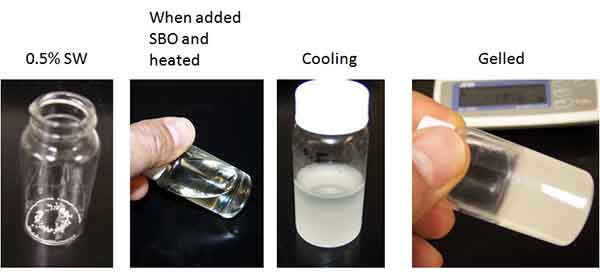
FIG. 1. Organogel formation from 0.5% sunflower wax (SW) in soybean oil (SBO) by dissolving SW with heat and cooling
Fig. 2 shows how the firmness of organogel depends on the amount of wax. Three waxes, SW, RBW, and CW were compared. As expected, organogel firmness increased with an increasing amount of wax. SW showed the greatest firmness, followed by CW and then RBW. The organogel containing 3% SW showed greater firmness than the gel containing about 20% hydrogenated soybean oil. The excellent gelling property of SW and the high firmness of the organogel were explained by the effective way in which the oil was immobilized with networks of numerous thin plate-like crystals (Hwang et al., 2015).
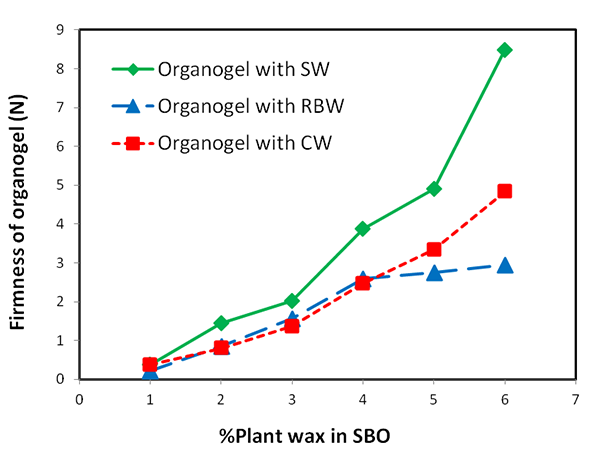 FIG. 2. Firmness (Newton, N) of organogels prepared with plant waxes
FIG. 2. Firmness (Newton, N) of organogels prepared with plant waxes
Preparation of margarine from organogel
A wax-SBO organogel was incorporated in a margarine formulation comprised of 80% organogel, about 20% water phase, and several minor ingredients such as emulsifiers and salt. Unfortunately, margarines containing CW showed phase separation. RBW-containing margarines showed very low firmnesses as shown in Fig. 3. Margarines prepared with SW-organogel showed the most promising results. It was found that while the firmness of commercial spread products ranged from 0.14-0.57 N, the hard margarine products showed much higher firmness ranging from 16.7-20.2 N. These results indicate that about 2% SW may be used in margarine to achieve the firmness of a commercial spread product. Firmness of the hard margarine could be achieved with 10% SW.
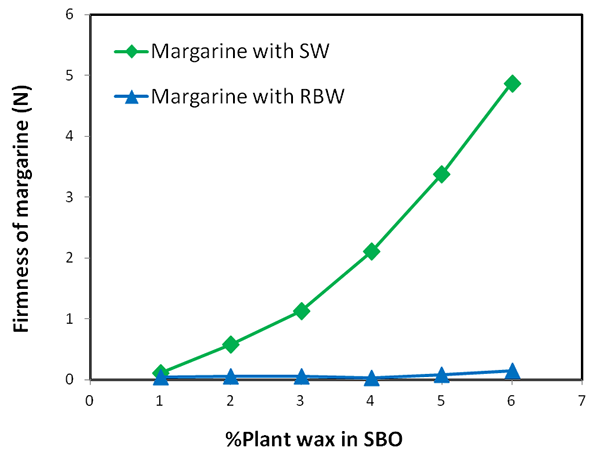
FIG. 3. Firmness (Newton, N) of margarine prepared with plant waxes
Fig. 4. shows the comparison between margarines prepared with SW and those with hydrogenated soybean oil. Margarines with 18-30% hydrogenated soybean oil showed slightly higher firmness than margarines with 2-6% SW. This result indicates that in terms of hardness characteristics, about 2-6 % SW may replace 18-30 % hydrogenated soybean oil in a margarine formulation.
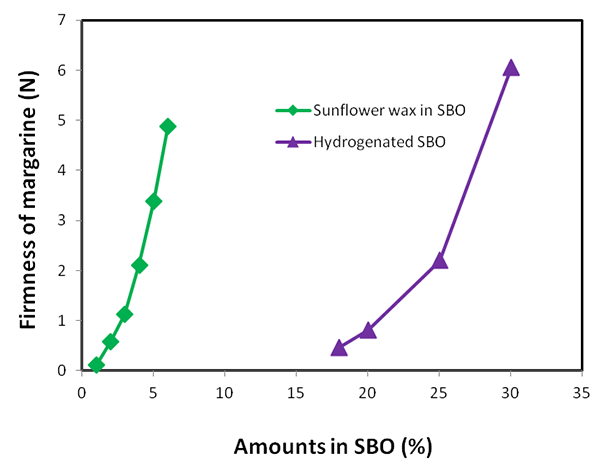
FIG. 4. Comparison of firmnesses (Newton, N) of margarines prepared with sunflower wax and hydrogenated soybean oil
Other vegetable oils
Since SW-SBO organogels worked well in the margarine formulation, a variety of healthy vegetable oils were evaluated to see whether they also could provide margarines with reasonable firmness and other properties. Fig. 5 shows the firmnesses of margarines prepared with 3% SW and 12 other vegetable oils. Their firmnesses were found to be comparable to that of SBO margarine, indicating that a number of healthful margarine and spread products can be made from vegetable oils rich in polyunsaturated fatty acids using SW as an organogelator.
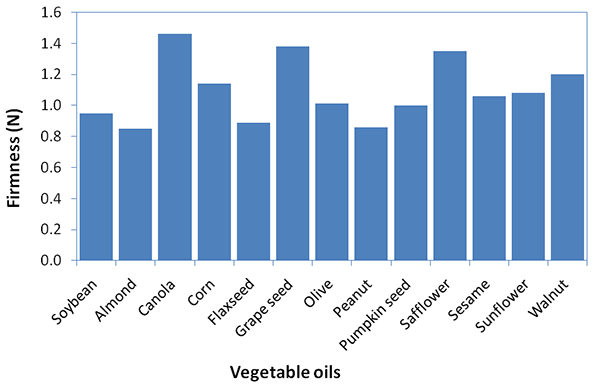
FIG. 5. Firmnesses (Newton, N) of margarines prepared with 3% sunflower wax (SW) in a variety of vegetable oils
Sensory attributes
Yilmaz, et al. (2015) studied sensory attributes of organogels of 5% beeswax in virgin olive oil and 5% SW in virgin olive oil as spreadable products compared to commercial breakfast margarine. Oleogels of hazelnut oil containing 5% wax were also evaluated as butter alternatives compared with commercial butter. This study provided data on 13 sensory definition terms (hardness, spreadability, liquefaction, grassy, milky, rancid, fatty, sweet, salty, waxy, grittiness, cooling, and mouth coating) for these organogels. Consumers gave these organogels good scores with respect to hedonic attributes (appearance, odor, flavor, and spreadability). Although some scores were somewhat lower than commercial products, overall these organogels demonstrated high potential as spreads or butter alternatives and could likely be commercialized after making minor improvements in their color, aroma and taste.
Other food products with high commercial potential that have been prepared from organogels of vegetable oils include ice cream, cookies, meat, bread, and chocolate.
Hong-Sik Hwang is a research chemist at the National Center for Agricultural Research (NCAUR)-Agricultural Research Service, US Department of Agriculture in Peoria, Illinois, USA. He has been with NCAUR since 2010. Prior to joining NCAUR, he worked for nine years at Indium Corporation. Hwang received his Ph.D. in organic chemistry from Texas Tech University, Lubbock, Texas, USA, in 1996. He can be contacted at HongSik.Hwang@ARS.USDA.GOV.
Recommended reading
Micha, R. and D. Mozaffarian, Saturated fat and cardiometabolic risk factors, coronary heart disease, stroke, and diabetes: A fresh look at the evidence, Lipids 45:893-905 (2010).
Marangoni, A. G., Organogels: An alternative edible oil-structuring method, J. Am. Oil Chem. Soc. 89:749-80 (2012).
Hwang, H.-S., S. Kim, K.O. Evans, C. Koga, and Y. Lee, Morphology and networks of sunflower wax crystals in soybean oil organogel, Food Struct. 5:10-20 (2015).
Yilmaz, E. and M. Ogutcu, Oleogels as spreadable fat and butter alternatives: Sensory description and consumer perception, RSC Adv. 5:50259-50267 (2015).
